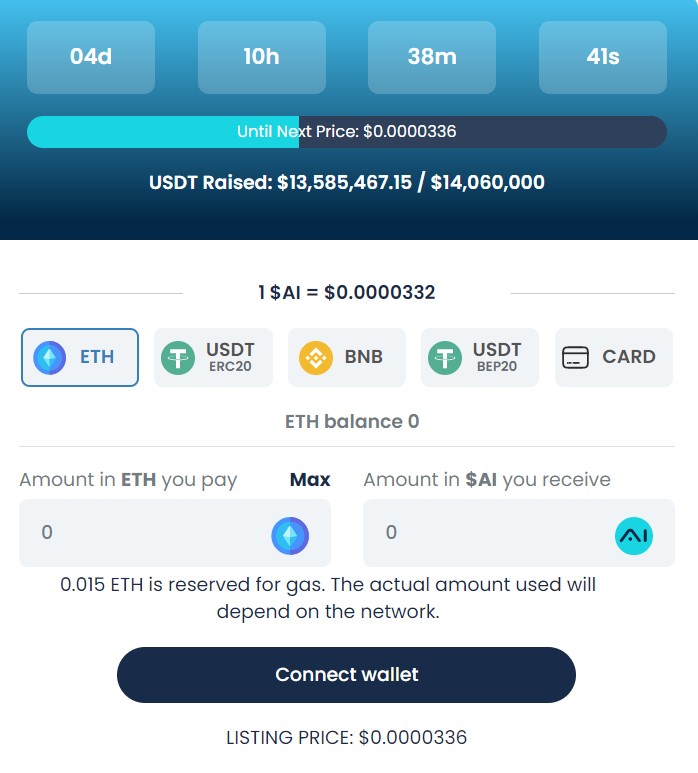As Pepe, RefundCoin, Shiba Inu Price Drop Further, Meme Token Investors Back This New Cryptocurrency Project

In a landscape where Pepe, RefundCoin, and Shiba Inu prices continue to nosedive, meme token investors are setting their sights on a new cryptocurrency venture that’s gaining momentum: AiDoge.
As uncertainty looms over established meme coins, this emerging project is garnering attention, positioning itself as a beacon of promise in the fluctuating realm of meme cryptocurrencies.
Let’s dive deeper into what AiDoge is bringing to the table, and why it’s winning the favor of investors in a world where other meme tokens are struggling to maintain their foothold.
Pepe Coin Price
As of today, the real-time value of Pepe stands at $0.000001, recording a 24-hour trading volume of $193,194,514.
Over the past day, Pepe has seen an uptick of 1.75%. Currently, it holds the 70th position on the CoinMarketCap ranking, boasting a live market capitalization of $569,101,834.
The total number of Pepe coins in circulation is 391,790,000,000,000, and the maximum supply is capped at 420,690,000,000,000 PEPE coins.
Shiba Inu Price
The current trading price of Shiba Inu is $0.000009, with its 24-hour trading volume standing at $96,914,564. Shiba Inu has seen a minor increase of 0.50% over the last day.
Shiba Inu holds the 15th position in the CoinMarketCap rankings, featuring a live market capitalization of $5,024,673,908.
The circulating supply consists of 589,353,648,453,732 SHIB coins.
Impact of High ETH Gas Fees on Solana (SOL) Coin Price and Adoption
As we mentioned previously, Ethereum Gas Fee surged to a 12-Month High, which in turn, many users are turning to the Solana network as an alternative because it offers faster and more cost-effective transactions.
It should be noted that the rising popularity of a meme coin called Pepe coin (PEPE) has caused transaction costs on the Ethereum network to soar. However, the daily median gas price, representing transaction fees, reached a 12-month high of 87 gwei.
This increase of over 50% has led users to seek alternatives like Solana, which offers faster and more cost-effective transactions.
Thus, this shift in user preference and increased adoption of Solana will potentially have a positive impact on the price of Solana (SOL) coins, helping it recover from its current downturn.
Integration of AI with Solana Blockchain and its Potential Impact
Solana, a popular blockchain network, has made a significant announcement regarding the integration of artificial intelligence (AI) through a ChatGPT plugin.
This marks the first time a Layer 1 blockchain has incorporated AI in this manner. The plugin allows users to interact with Solana data and protocols more easily, making tasks such as buying NFTs, transferring tokens, and accessing transaction information simpler.
This development is expected to enhance the usability and understanding of Solana network.
Revolution in Meme Coin Market: AiDoge’s Success with Unique AI and Presale Growth
With AiDoge nearing the end of its successful presale, a wave of excitement is surging through the crypto sphere.
This project sets itself apart from other meme coin ventures by uniquely blending artificial intelligence features with the whimsical charm of meme tokens, thereby capturing the attention of cryptocurrency enthusiasts.
So far, AiDoge has accumulated an impressive $13.5 million in its presale. The introduction of a layer-2 solution, offering reduced fees and faster transactions, has only further bolstered its appeal, making it a stand-out contender in the bustling meme coin market.
This innovative platform presents a novel meme-to-earn (M2E) ecosystem, empowered by advanced AI technology, inviting all to partake in meme-making. With the platform’s $AI token incentives, generating memes turns into a rewarding income stream. Furthermore, users can purchase credits for meme creation and stake their tokens, reaping additional benefits.

Meme coins have often been associated with speculation, but AiDoge is changing this narrative by introducing an innovative approach that fosters community engagement.
As the pioneer and exclusive M2E token, AiDoge is poised to significantly influence the cryptocurrency landscape, showing that memes can extend beyond simple amusement.
Become a part of the AiDoge community today and experience the potency of memes in the cryptocurrency universe.






 Bitcoin
Bitcoin  Ethereum
Ethereum  Tether
Tether  USDC
USDC  TRON
TRON  Dogecoin
Dogecoin  Cardano
Cardano  Bitcoin Cash
Bitcoin Cash  Chainlink
Chainlink  Monero
Monero  LEO Token
LEO Token  Stellar
Stellar  Zcash
Zcash  Litecoin
Litecoin  Hedera
Hedera  Dai
Dai  Cronos
Cronos  Tether Gold
Tether Gold  OKB
OKB  Ethereum Classic
Ethereum Classic  KuCoin
KuCoin  Gate
Gate  Algorand
Algorand  Cosmos Hub
Cosmos Hub  VeChain
VeChain  TrueUSD
TrueUSD  Dash
Dash  Tezos
Tezos  Stacks
Stacks  IOTA
IOTA  Basic Attention
Basic Attention  Theta Network
Theta Network  Decred
Decred  NEO
NEO  Synthetix
Synthetix  Qtum
Qtum  Ravencoin
Ravencoin  DigiByte
DigiByte  0x Protocol
0x Protocol  Nano
Nano  Zilliqa
Zilliqa  Siacoin
Siacoin  Numeraire
Numeraire  Waves
Waves  BUSD
BUSD  Status
Status  Pax Dollar
Pax Dollar  Enjin Coin
Enjin Coin  Ontology
Ontology  Hive
Hive  Lisk
Lisk  Steem
Steem  Huobi
Huobi  OMG Network
OMG Network  NEM
NEM  Bitcoin Gold
Bitcoin Gold  Augur
Augur  HUSD
HUSD  Ren
Ren